

U.S. Department Of Transportation
Federal Highway Administration
September 1980
HEV-21/8-80(20M)
For sale by the Superintendent of Documents, U.S. Government Printing Office, Washington, D.C. 20402
Top
NPC Online Library
NPC Law Library
NPC Noise News
NPC Resources
NPC Home
In recent years highway traffic noise-the unpleasant, unwanted sounds generated on our Nation's streets and highways-has been of increasing concern both to the Public and to local, State, and Federal officials. At the same time, modern acoustical technology has been providing better ways to lessen the adverse impacts of highway traffic noise. The Purpose of this pamphlet is to explain some of these acoustical techniques which are now being employed by government agencies, highway planners and designers, construction engineers, and private developers.
As we all know, sound is created when an object moves: the rustling of leaves as the wind blows, the air passing through our vocal chords, the almost invisible movement of the speakers on a stereo. The movements cause vibrations of the molecules in air in waves like ripples on water. When the vibrations reach our ears, we hear what we call sound.
Sound is quantified by a meter which measures units called decibels (dB). For highway traffic noise, an adjustment, or weighting, of the high- and low-pitched sounds is made to approximate the way that an average person hears sounds. The adjusted sounds are called "A-weighted levels"(dBA).
The A-weighted decibel scale begins at zero. This represents the faintest sound that can be heard by humans with very good hearing. The loudness of sounds (that is, how loud they seem to humans) varies from person to person, so there is no precise definition of loudness. However, based on many tests of large numbers of people, a sound level of 70 is twice as loud to the listener as a level of 60. This principle is illustrated an the next page.
2
Top
NPC Online Library
NPC Law Library
NPC Noise News
NPC Resources
NPC Home
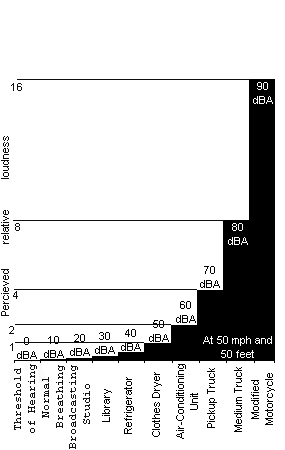
3
Top
NPC Online Library
NPC Law Library
NPC Noise News
NPC Resources
NPC Home
The level of highway traffic noise depends on three things: (1) the volume of the traffic, (2) the speed of the traffic, and (3) the number of trucks in the flow of the traffic. Generally, the loudness of traffic noise is increased by heavier traffic volumes, higher speeds, and greater numbers of trucks. Vehicle noise is a combination of the noises produced by the engine, exhaust, and tires. The loudness of traffic noise can also be increased by defective mufflers or other faulty equipment on vehicles. Any condition (such as a steep incline) that causes heavy laboring of motor vehicle engines will also increase traffic noise levels. In addition, there are other more complicated factors that affect the loudness of traffic noise. For example, as a person moves away from a highway, traffic noise levels are reduced by distance, terrain, vegetation, and natural and manmade obstacles. Traffic noise is not usually a serious problem for people who live more the.500 feet from heavily traveled freeways or more than l00 to 200 feet from lightly traveled roads.
How Traffic Volume Affects Noise
A
![]()
2000 vehicles per hour
B
![]()
200 vehicles per hour
A sounds twice as loud as B.
4
Top
NPC Online Library
NPC Law Library
NPC Noise News
NPC Resources
NPC Home
How Speed Affects Traffic Noise
A
![]()
55 miles per hour
B
![]()
15 miles per hour
A sounds twice as loud as B.
_____________________________________
How Trucks Affect Traffic Noise
A
![]()
One Truck
B
![]()
![]()
32 cars
A sounds as loud as B.
5
Top
NPC Online Library
NPC Law Library
NPC Noise News
NPC Resources
NPC Home
Highway traffic noise is never constant. The noise level is always changing with the number, type, and speed of the vehicles which produce the noise. Traffic noise variations can be plotted, as shown by the graph below. It is usually inconvenient and cumbersome to use such a graph to represent traffic noise in this manner. A more practical method is to convert the noise data to a single representative number.
Statistical descriptors are almost always used as a single number to describe varying traffic noise levels. The two most common statistical descriptors used for traffic noise are L10 and Leq. L10 is the sound level that is exceeded 10 percent of the time.
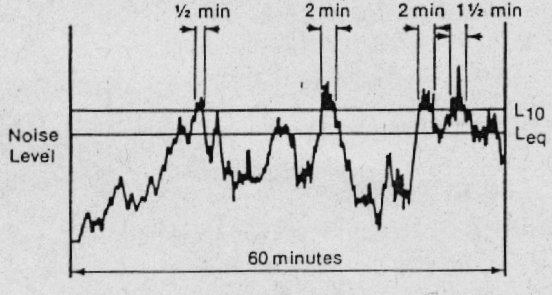
From the above graph, it can be seen that the shaded areas represent the amount of time that the L10 value is exceeded. Adding each interval during which this occurred shows that during the 60-minute measuring period the L10 was exceeded 6 minutes (1/2 + 2 + 2 +11/2 = 6) or 10 percent of the time. The calculation of Leq is more complex. Leq is the constant, average sound level, which, over a period of time, contains the same amount of sound energy as the varying levels of the traffic noise. Leq for typical traffic conditions is usually about 3 dBA less than the L10 for the same conditions.
The Federal Highway Administration has established noise impact criteria for different land uses close to highways. Some of the exterior criteria are illustrated below.
| Land Use | L10 | Leq |
| Residential | 70 dBA | 67 dBA |
| Commercial | 75 dBA | 72 dBA |
If a project causes a significant increase in the future noise level over the existing noise level, it is also considered to have an impact.
6
Top
NPC Online Library
NPC Law Library
NPC Noise News
NPC Resources
NPC Home
Highway noise is being attacked with a three-part strategy: motor vehicle control, land use control, and highway planning and design.
The responsibilities for implementing these strategies must be shared by all levels of government: Federal, State, and local. Often local officials can most effectively solve specific noise problems in their areas, as demonstrated in the U.S. Environmental Protection Agency's (EPA) Quiet Community and Each Community Helps Others (ECHO) programs. The following two sections briefly describe how traffic noise impacts can be reduced or prevented through efforts to obtain quieter vehicles and efforts to control the future development near highways. Most of the remainder of this pamphlet focuses mainly on noise abatement in the Federal-aid highway program.
The first strategy goes right to the source of traffic noise: the vehicles. These vehicles can be designed with, for example, enclosures for the engine, fans that turn off when not needed, and better mufflers. Quieter vehicles would bring about a substantial reduction in traffic noise along those roads and streets where no other corrective measures are possible. The EPA has issued regulations which place a limit on the noise which new trucks can make. In addition, many local and State governments have passed ordinances or laws requiring existing vehicles to be properly maintained and operated.
Unfortunately, due to limitations in technology, these EPA regulations for new trucks and State and local regulations for maintenance of vehicles can only partially reduce the noise created by traffic. The best that can be expected is a 5 to 10 dBA decrease in the noise level. Where larger reductions are needed, other techniques need to be employed.
A second part of this strategy calls for the control of future development. Sometimes complaints about highway traffic come from occupants of new homes built adjacent to an existing highway. Many of these highways were
7
Top
NPC Online Library
NPC Law Library
NPC Noise News
NPC Resources
NPC Home
originally constructed through undeveloped lands. There are several hundred thousand miles of existing highways in this country bordered by vacant land, which may some day be developed. Prudent land use control can help to prevent many future traffic noise problems in these areas. Such controls need not prohibit development, but rather they can require reasonable distances between buildings and roads, as well as "soundproofing" or other abatement measures to lessen noise disturbances. Many local governments are working on land use control.
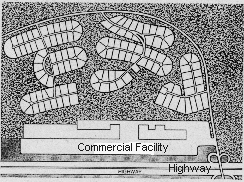
Less noise-sensitive commercial buildings can be placed next to a highway with residences further away.
Early in the planning stages of most highway improvements, highway agencies do a noise study. The purpose of this study is to determine if the project will create any noise problems. First, the existing noise levels of a highway are measured or computed by models. Then, the agency predicts what the noise levels will be if the project is constructed. If the predicted noise levels are above Federal noise criteria, the noise study must consider measures that can be taken to lessen these adverse noise impacts. (See page 6 for examples of the criteria.) This information is reported at public meetings and hearings, if they occur. There are a variety of things that a highway agency can do to lessen the impacts of highway traffic noise.
8
Top
NPC Online Library
NPC Law Library
NPC Noise News
NPC Resources
NPC Home
Some noise reduction measures that are possible on existing roads or on roads that are being rebuilt include creating buffer zones, planting vegetation, constructing barriers, installing noise insulation in buildings, and managing traffic.
Buffer zones are undeveloped, open spaces which border a highway. Buffer zones are created when a highway agency purchases land, or development rights, in addition to the normal right-of-way, so that future dwellings cannot be constructed close to the highway. This prevents the possibility of constructing dwellings that would otherwise have an excessive noise level from nearby highway traffic. An additional benefit of buffer zones is that they often improve the roadside appearance. However, because of the tremendous amount of land that must be purchased and because in many cases dwellings already border existing roads, creating buffer zones is often not possible.
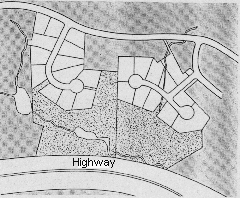
Open space can be left as a buffer zone between residences and a highway
9
Top
NPC Online Library
NPC Law Library
NPC Noise News
NPC Resources
NPC Home
Noise barriers are solid obstruction built between the highway and the homes along the highway. Effective noise barriers can reduce noise levels by 10 to 15 decibels, cutting the loudness of traffic noise in half. Barriers can be formed from earth mounds along the road (usually called earth berms) or from high, vertical walls. Earth berms have a very natural appearance and are usually attractive. However, an earth berm can require quite a lot of land if it is very high. Walls take less space. They are usually limited to 25 feet in height because of structural and aesthetic reasons. Noise walls can be built out of wood, stucco, concrete, masonry, metal, and other materials. Many attempts are being made to construct noise barriers that are visually pleasing and that blend in with their surroundings.
However, barriers do have limitations. For a noise barrier to work, it must be high enough and long enough to block the view of a road. Noise barriers do very little good for homes on a hillside overlooking a road or for buildings which rise above the barrier. Openings in noise walls for driveway connections or intersecting streets destroy the effectiveness of barriers. In some areas, homes are scattered too far apart to permit noise barriers to be built at a reasonable cost.
10
Top
NPC Online Library
NPC Law Library
NPC Noise News
NPC Resources
NPC Home
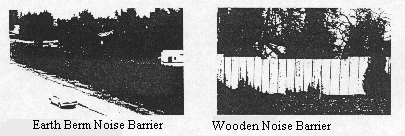
11
Top
NPC Online Library
NPC Law Library
NPC Noise News
NPC Resources
NPC Home
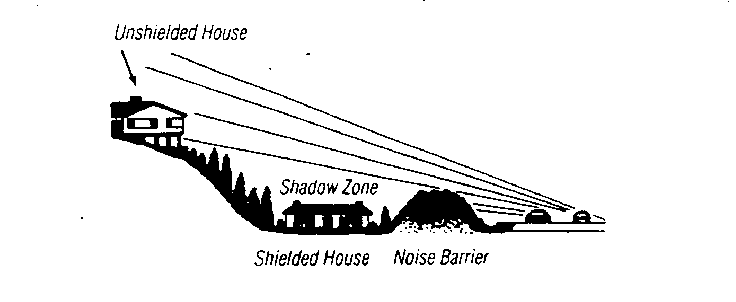
Shadow Effect of Noise Barrier
The lower house is protected by the barrier, but the upper one is
not.
Vegetation, if it is high enough, wide enough, and dense enough that it cannot be seen through, can decrease highway traffic noise. A 200-foot width of dense vegetation can reduce noise by 10 decibels, which cuts in half the loudness of traffic noise. It is often impractical, however, to plant enough vegetation along a road to achieve such reductions. But, if dense vegetation already exists, it could be saved. If it does not exist, roadside vegetation can be planted to create a psychological relief, if not an actual lessening of traffic noise levels.
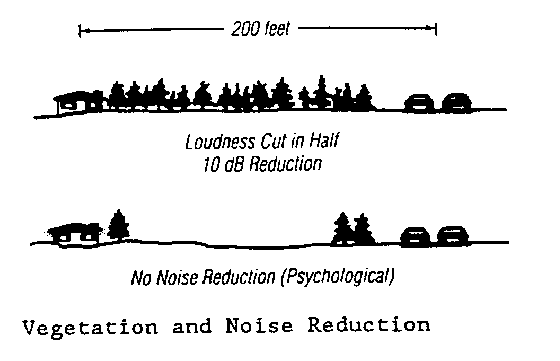
12
Top
NPC Online Library
NPC Law Library
NPC Noise News
NPC Resources
NPC Home
Insulating buildings can greatly reduce highway traffic noise, especially when windows are sealed and cracks and other openings are filled. Sometimes noise-absorbing material can be placed in the walls of new buildings during construction. However, insulation can be costly because air conditioning is usually necessary once the windows are sealed.
In many parts of the country, highway agencies do not have the authority to insulate buildings; thus, in those States insulation cannot be included as part of a highway project.
Controlling traffic can sometimes reduce noise problems. For example, trucks can be prohibited from certain streets and roads, or they can be permitted to use certain streets and roads only during daylight hours. Traffic lights can be changed to smooth out the flow of traffic and to eliminate the need for frequent stops and starts. Speed limits can be reduced; however, about a 20 mile-per-hour reduction in speed is necessary for a noticeable decrease in noise levels.
Pavement is sometimes mentioned as a factor in traffic noise. While it is true that noise levels do vary with changes in pavements and tires, it is not clear that these variations are significant when compared to the noise from exhausts and engines, especially when there are a large number of trucks on the highway. More research is needed to determine to what extent different types of pavements and tires contribute to traffic noise. Until this research is completed, the use of different types of pavement cannot be depended upon to reduce traffic noise.
13
Top
NPC Online Library
NPC Law Library
NPC Noise News
NPC Resources
NPC Home
All of the measures described above can be employed on both existing roads and on new roads. There are, however, some additional measures which can usually be used only on new roads. First, a new road can be located away from noise sensitive areas, such as schools or hospitals, and placed near nonsensitive areas, such as businesses or industrial plants. New roads can also be located in undeveloped areas.
Second, a new road can be constructed below ground level. Much of the noise from vehicles traveling on this type of road is deflected into the air by embankments on the side of the road. Thus, these embankments function in much the same way as noise barriers.
Third, a new road can be designed and constructed as level as possible. The elimination of steep inclines helps to reduce traffic noise because motor vehicle engines, especially multigeared truck engines, do not have to work as hard.
Although there are a great many noise reduction measures possible, they all have limitations. Consequently, there are many situations where none of these noise reduction measures can be used. In these situations the only option left may be for local authorities to require adequate muffler devices for the louder vehicles:
14
Top
NPC Online Library
NPC Law Library
NPC Noise News
NPC Resources
NPC Home
The Federal Highway Administration (FHWA) is the agency responsible for administering the Federal-aid highway program. Under this program, Federal funds are allotted by Congress to the individual States. However, before these monies can be used for highway projects, the projects must be approved by FHWA, which can only grant its approval for projects that are developed in accordance with Federal statutes and regulations. One of these regulations requires that a noise study be accomplished to determine what noise impacts, if any, will result from the proposed highway improvement and what measures will be taken to lessen these noise impacts. If noise impacts are expected, then noise reduction measures that are determined by the State highway agency and the FHWA to be practicable, reasonable, and acceptable to the public must be incorporated into the highway improvement. The costs of the noise reduction measures are included with the other costs of the highway improvement and are eligible for Federal funding in the same proportion as other aspects of the project.
State highway agencies may also use Federal highway grants for noise reduction projects on existing roads on the Federal-aid system. The monies spent on noise reduction measures are deducted from funds which would otherwise be available for highway construction.
Federal funds may be used for the construction of noise barriers, for acquisition of land on which to build such barriers, and for the purchase of undeveloped lands as a preemptive buffer zone. Traffic operational measures such as truck routes and restriction of hours of operation are often feasible noise abatement measures, and the costs of such measures are eligible for Federal fundings. The "soundproofing" of public-use institutional buildings may be incorporated in Federal-aid highway projects to abate traffic noise, but the use of Federal funds for soundproofing commercial buildings or private dwellings is not normally permitted.
15
![]()